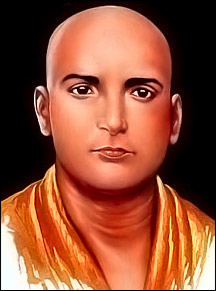 Swami Rama Tirtha was previously known as Gossain Tirtha Rama. He was born at Murariwala, a village in the district of Gurjanwala in Punjab in the year 1873. He lost his mother when he was a few days newborn child and thereafter his elder brother Gossain Gurudas brought him up.
Swami Rama Tirtha was previously known as Gossain Tirtha Rama. He was born at Murariwala, a village in the district of Gurjanwala in Punjab in the year 1873. He lost his mother when he was a few days newborn child and thereafter his elder brother Gossain Gurudas brought him up.
When Sri Rama Tirtha was a young boy only he was very fond of listening to recitations from the Holy Scriptures and attending Kathas. He often asked questions to holy men and sometimes took part in their discussions. He was an intelligent boy who preferred solitude.
Sri Rama was only ten years old when his father got him married. His father put him under the care of Bhakta Dhana Rama who was a pure and simple man. Rama regarded him as his Guru and offered him a great devotion of mind and body. He surrendered to him completely and never did anything without his consent.
Rama was a brilliant student, especially in Mathematics. After he earned his degree, he served for a while as Professor of Mathematics in the Forman Christian college. It was the stage that his spiritual life began to flourish. He began to read the Gita and became the great Devotee of lord Krishna. He started delivering lectures on Bhakti under the guidance of the Sanatana Dharma Sabha of Lahore.
Rama Tirtha commenced his spiritual life as a Bhakta of God and then started studying Vedanta under the inspiration of Sri Madhava Tirtha of Dwaraka Math. His spiritual life was more inspired when he met Swami Vivekananda whom he met at Lahore. The sight of Vivekananda brought an impulse in him to long for the ochre robe of the Sannyasin.
Swami Rama Tirtha`s passion grew more for the vision of all-pervading Lord. He longed to get the oneness with God. Swami Rama Tirtha became indifferent to food and clothes and was filled with ecstatic joy. Tears often came out from his eyes and ran down through his cheeks. After sometime he had the vision he yearned for and thereafter he lived, moved and had his being in Supreme Lord.
Swami Rama Tirta was a living legend and a great Vedantin. He saw and felt God in all names and forms. Sometimes he used to address the trees, rivers and mountains. He soon resigned his post and left for the forest. His wife and two children and few other followers accompanied him to the Himalayas. But his wife soon got ill and returned with one of her sons. The other son was left at Tehri and had his schooling there.
Rama Tirtha took Sannyas a few days before the passing of Swami Vivekananda. Swami Madhava Tirtha had already allowed him to take Sannyas whenever he wished.
A few years later Swami Rama Tirtha returned to the plains to preach the common men. He enchanted everyone with his eternal ecstasy and uttering of Om mantra.
Swami Rama Tirtha desired to spread the message of Vedanta to all over the world and so he departed for Japan with his disciple Swami Narayana. After a successful visit to Tokyo, he started his journey to USA. Swami Rama Tirtha spent about a year and a half under the hospitality of Dr, Albert Hiller. He had gained a large number of disciples and started many societies. One of the societies was Hermetic Brotherhood, which was dedicated to the study of Vedanta. He had great influence on the Americans with his charming personality. The devout Americans even called him as living Christ.
When he returned to India, Swami Rama continued with his lectures in different regions of India but his health deteriorated. He went back to Himalayas and settled at Vasistha Ashram. He gave up his body in the GaGanges on the October 17, 1906, at the age of thirty-three only.
The Rama Tirtha Publication League has published most of the writings of swami Rama Tirtha. These are issued in several volumes, entitled `In the woods of God-realization`. His inspiring writings reveal that he saw his beloved Lord in all names and forms. In many of his poems Swami Rama Tirtha sings the glory of the nature.









